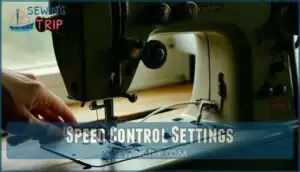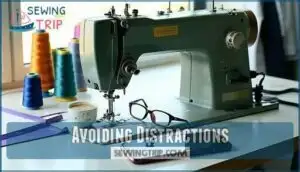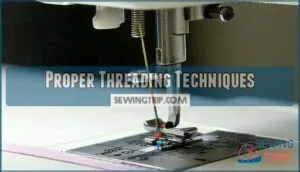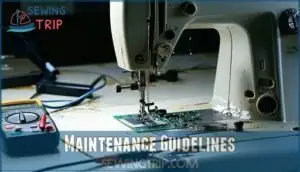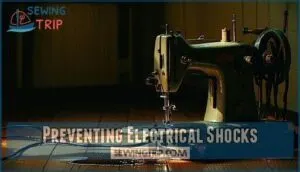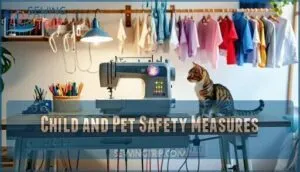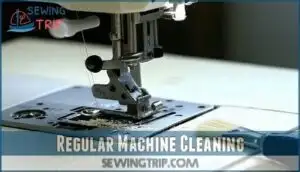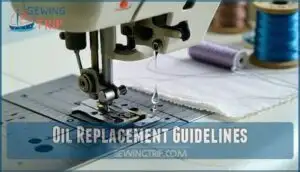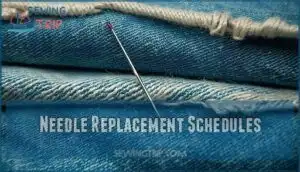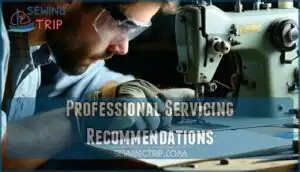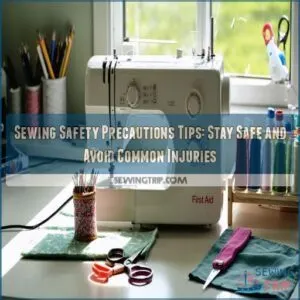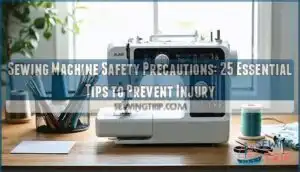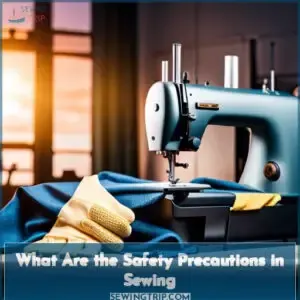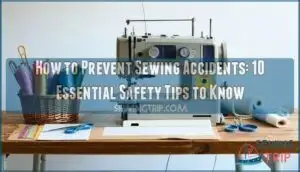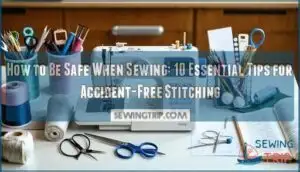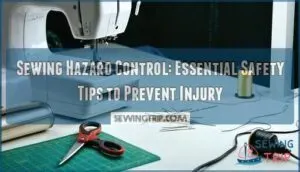This site is supported by our readers. We may earn a commission, at no cost to you, if you purchase through links.
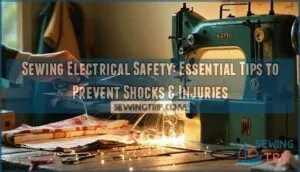
Always unplug your machine before threading, cleaning, or making adjustments – it’s like brushing your teeth with the water running, unnecessary and risky.
Keep electrical cords away from water and heat sources, and inspect them regularly for fraying or damage.
Don’t overload outlets with multiple machines, and use surge protectors to shield your equipment from power spikes.
Check that your hands are dry before touching electrical components, and never yank cords from outlets.
Think of electrical safety as the foundation of your sewing space – get it right, and everything else falls into place.
Smart sewers know these basics prevent most workshop accidents, and following them is crucial for a safe and productive sewing environment.
Table Of Contents
Key Takeaways
- Always unplug your sewing machine before making any adjustments, threading, or cleaning – this prevents accidental starts and electrical shocks while you’re working on the machine.
- Inspect power cords monthly for fraying, cracks, or damage and replace them immediately if you find any issues – never attempt to repair damaged cords with tape as this creates fire and shock hazards.
- Use surge protectors with at least a 1,000 joules rating for your sewing equipment and avoid overloading outlets with multiple high-wattage machines to prevent electrical fires and equipment damage.
- Keep your workspace organized with proper cord management, designated tool storage, and adequate lighting to prevent tripping hazards and accidental contact with electrical components while sewing.
Electrical Safety Basics
Before you start your sewing project, you’ll need to master the electrical safety fundamentals that protect you from dangerous shocks and injuries.
These basic precautions create a secure workspace where you can focus on your craft instead of worrying about electrical hazards.
Handling Sharp Tools
Your sharp tools pose both electrical and physical hazards when mishandled around sewing machines. Proper handling prevents cuts, needle breaks, and accidental contact with electrical components that could cause dangerous shocks.
- Needle disposal: Store used needles in sealed containers to prevent piercing injuries and electrical contact
- Pincushion safety: Use magnetic holders near machines to avoid pins falling into electrical components
- Scissor handling: Keep blades retracted and pointed away from power cords to prevent accidental cuts
To guarantee safety, always adhere to sewing machine safety precautions.
Unplugging Machines
Before performing any electrical work, always unplug your sewing machine completely from the wall outlet.
This simple step prevents accidental starts when changing needles or threading, protecting you from electrical hazards sewing enthusiasts often overlook.
Unplugging benefits include eliminating voltage surges and reducing fire risks.
While cordless alternatives exist, most machines require this essential electrical safety tip for ideal power cord safety during maintenance.
Regular Cord Inspection
Before plugging in your sewing machine, inspect power cords for fraying hazards like exposed wires or cracked insulation. Check connection security where plugs meet outlets, ensuring they’re snug without forcing.
Watch for damage signs including discoloration, brittleness, or unusual warmth during use. Identifying damaged cord products early can prevent accidents.
Replace damaged sewing machine cords immediately—don’t attempt repairs with tape. For safe storage, coil cords loosely to prevent kinking and maintain electrical cord safety throughout your machine’s lifespan, ensuring electrical cord safety and preventing accidents.
Surge Protector Usage
Power strips aren’t surge protectors—you need dedicated surge protection for your sewing machine.
Look for units with at least 1,000 joules rating and proper grounding. Install surge protectors correctly by plugging directly into wall outlets, never daisy-chaining power strips.
They protect multiple devices simultaneously and indicate when surge events occur. Finding the right unit may require exploring available options.
Replace surge protectors every 3-5 years for maximum electrical safety.
Safe Sewing Machine Operation
Your sewing machine’s a powerful tool that deserves the same respect you’d give any piece of electrical equipment.
Think of it like driving a car—you wouldn’t text while operating in traffic, and you shouldn’t multitask while guiding fabric through moving needles, just as you would avoid distractions while driving.
Speed Control Settings
How do you control speed when tackling complex seams? Your sewing machine safety depends on using slower speeds for intricate work.
Start beginner projects at low speeds to master fabric control and prevent electrical hazards. Consistent stitching comes from steady, controlled movements—not racing through seams.
Slower speeds protect motor longevity while ensuring precision. Use surge protectors and inspect electrical cords regularly for complete safety, which is crucial for sewing machine safety.
Avoiding Distractions
A quiet environment is your best friend for sewing machine safety.
Distractions can lead to electrical hazards and sewing machine accidents faster than you can say “bobbin.”
Use Focus Techniques and Mindful Sewing—minimize interruptions, eliminate multitasking, and keep your eyes on the needle.
Electrical safety starts with attention; treat your machine like a power tool, not background noise.
Proper Threading Techniques
Threading your machine correctly prevents electrical safety hazards like sudden stops that could cause needle injuries.
Start by turning off your sewing machine completely before threading to avoid accidental needle movement.
- Tension Balance: Adjust upper and lower thread tensions evenly to prevent thread breaks that require emergency stops
- Thread Types: Match thread weight to your needle size – heavier threads need larger needles for smooth operation
- Needle Size: Use appropriate needle sizes for your fabric to prevent jamming and machine strain
- Bobbin Winding: Wind bobbins evenly and avoid overfilling to prevent thread tangles during operation
Proper threading techniques are fundamental to sewing machine safety and electrical shock prevention. When you thread correctly, you’ll avoid sudden machine jams that could lead to hasty troubleshooting near moving parts.
Maintenance Guidelines
Like a car that needs regular tune-ups, your sewing machine requires consistent maintenance to prevent electrical hazards.
Clean your machine every 8-10 hours of use, removing lint buildup that can cause overheating. Oil moving parts monthly following your manual’s oiling procedures.
Check tension adjustments regularly, and replace worn parts immediately. Keep a troubleshooting guide handy for quick fixes.
Proper sewing machine maintenance isn’t just about performance—it’s vital electrical safety tips that prevent dangerous malfunctions and guarantee your surge protection sewing setup works effectively, ensuring regular tune-ups and consistent maintenance.
Preventing Electrical Shocks
Working with electrical equipment while sewing can be dangerous if you don’t follow proper safety protocols.
You’ll face serious risks like electrical shocks, burns, or even fires if you skip essential precautions like unplugging your machine before making adjustments.
Unplugging Before Repairs
Never attempt electrical repairs on your sewing machine while it’s plugged in. This simple rule prevents accidental starts and electrical shock sewing incidents.
Always unplug the power cord before accessing internal components, changing parts, or troubleshooting issues. This shock prevention step protects you from live circuits and guarantees safe component access. Remember, cord safety starts with disconnection.
To further guarantee safety, consider unplugging when idle. Taking this precaution extends machine longevity by preventing electrical damage during sewing machine repair work.
Avoiding Overloaded Outlets
Electrical safety starts with respecting your outlet capacity.
Don’t plug multiple high-wattage appliances into one outlet—this overloads circuits and creates electrical hazards.
Your sewing machine, iron, and serger each draw significant power.
Use separate outlets or install additional circuits to handle the load.
Power strips aren’t magic solutions; they don’t increase outlet capacity.
Circuit breakers trip for good reason—they’re protecting you from electrical fires.
Consider a heavy-duty extension cord rated for your equipment’s needs.
This is crucial for preventing electrical fires and ensuring safety.
Using Voltage Transformers
When your sewing machine operates in regions with different voltages, voltage transformers become your safety shield. Transformer selection protects international sewing equipment from electrical hazards and prevents damage through proper step-down usage.
Consider these power compatibility essentials:
- Calculate wattage needs – Choose transformers rated 1.5x your machine’s power requirements
- Match voltage specifications – Use step-down transformers for 110V machines in 220V regions
- Verify frequency compatibility – Electronic models need precise frequency matching for safe operation
- Include surge protection sewing – Integrated grounding features dissipate fault currents effectively
- Ensure proper ventilation – Aluminum-shell transformers prevent overheating during extended use
Grounding transformers are essential to manage fault currents in the event of electrical issues. Professional consultation prevents costly mistakes when selecting electrical safety equipment for your sewing machine grounding system.
Regular Power Cord Inspection
Check your electrical cords monthly for fraying hazards and connection security.
Look for cracks, burns, or exposed wires that signal replacement frequency has arrived.
Damaged cords cause fires and shocks—never patch them with tape.
When using extension cordage, verify voltage compatibility with your machine.
Monthly inspections are highly recommended for safety.
Replace worn cords immediately to maintain electrical safety awareness and protect your investment.
Sewing Area Organization
A well-organized sewing area isn’t just about looking tidy—it’s your first defense against electrical hazards and workplace injuries.
You’ll create a safer, more efficient workspace by establishing proper furniture placement, installing adequate lighting, and designating specific zones for different tasks to ensure a more efficient environment.
Ergonomic Furniture Setup
Your back will thank you for setting up ergonomic furniture properly, just like electrical cords need careful routing to prevent hazards.
Position your sewing table at elbow height, guaranteeing your arms bend at 90 degrees. Choose adjustable height chairs with lumbar support to maintain proper posture during long sessions.
- Adjustable Height Table – Set surface so elbows rest comfortably at 90-degree angles
- Ergonomic Chairs – Select seats with lumbar support and adjustable features for posture support
- Workspace Layout – Position surge protectors and power strip within easy reach but away from feet
- Heavy-duty Extension Cord – Route electrical cords along walls to prevent tripping hazards
- Ergonomic Furniture – Guarantee feet rest flat on floor with thighs parallel to ground
Proper Lighting Installation
Good lighting prevents eye strain and makes precision work safer.
Install LED lights offering 1,000-2,000 lux for general tasks, with task lighting reaching 5,000-10,000 lux for detailed work.
Position adjustable lights directly above your sewing machine needle to eliminate shadows.
Choose daylight-balanced bulbs (5000K-6500K) for accurate color rendering.
Always switch off power at the circuit breaker before installing fixtures to prevent electrical shocks during setup.
Decluttering The Workspace
Clearing clutter boosts workflow efficiency and mental clarity, while cutting accident risks.
Here’s how to optimize your space:
- Store sharp tools away for accident prevention.
- Bundle electrical cords with cord safety tips.
- Use a heavyduty extension cord for sewing machine wires.
- Toss fabric scraps—no trip hazards.
- Arrange supplies for ergonomic benefits and space optimization.
By following these steps, you can create a safer and more efficient workspace, which ultimately enhances your overall mental clarity.
Designating Safety Zones
Once you’ve cleared clutter from your workspace, create distinct sewing zones to prevent accidents and maintain workflow efficiency. Establish clear pathways between areas to avoid tripping over electrical cords or materials.
Your ergonomic layout should include designated spaces for cutting, sewing, and pressing.
| Zone Type | Safety Features |
|---|---|
| Cutting Area | Sharp tool storage, non-slip mats, supervised access for beginners |
| Sewing Station | Heavyduty extension cord management, emergency access routes, surge protection |
| Pressing Zone | Heat-resistant surfaces, cord routing, hazard prevention measures |
Strategic zone placement reduces short circuits and electrical fires while ensuring smooth project flow.
Child and Pet Safety Measures
When you’re sewing with little ones or pets around, your workspace becomes their playground too.
You’ll need to childproof your sewing area and teach basic safety rules to keep everyone safe while you create.
Supervising Children
When children are around your sewing space, constant supervision becomes your top priority.
Never leave kids unattended near running machines or exposed electrical cords that could cause electrical fires.
Children and electrical equipment don’t mix—keep little hands away from power cords and moving parts.
Create childproofing workspace measures by establishing clear boundaries and assigning age-appropriate tasks.
Teaching sewing safety precautions early helps children understand sewing hazards.
Develop emergency protocols for accidents, ensuring child supervision includes education importance about sewing machine safety.
Securing Sharp Tools
Sharp tools pose real dangers when kids and pets are around. Store needles, scissors, pins, and seam rippers in lockable containers or high cabinets they can’t reach. General safety precautions are essential for preventing accidents.
General safety precautions can be found online for more information on how to stay safe while sewing.
- Use magnetic holders for pins and needles – they’re safer than scattered pincushions
- Install rotary cutter blade guards immediately after each use
- Create designated needle disposal containers with tight-fitting lids
- Choose pincushion safety by selecting wrist-worn styles over tabletop versions
- Implement safe storage systems with childproof latches on all tool drawers to ensure a secure environment.
Teaching Safety Precautions
Teaching kids about sewing machine electrical safety starts with age-appropriate rules and demonstrations.
Show them proper cord handling, outlet safety, and never touching plugs with wet hands.
Use supervised practice sessions to reinforce these sewing safety precautions.
Make electric shock prevention fun through simple games that teach safe behaviors around electrical equipment, promoting a culture of safety.
Preventing Accidental Injuries
Beyond establishing ground rules, you’ll need practical prevention strategies to stop sewing machine injuries and electric shock incidents.
Create finger guards for needle safety, maintain safe speed settings, and store sharp tools securely.
Schedule regular breaks every thirty minutes to prevent fatigue-related sewing accidents.
Keep your workspace organized with designated zones for different activities, ensuring proper lighting reduces eye strain and potential mishaps during detailed work, which is crucial for overall sewing machine safety.
Maintenance and Inspection
Your sewing machine needs regular care to stay safe and prevent electrical problems.
A neglected sewing machine is a safety hazard waiting to happen.
Think of maintenance like changing the oil in your car – skip it, and you’re asking for trouble down the road.
Regular Machine Cleaning
Clean your sewing machine monthly to prevent electrical hazards and guarantee smooth operation.
Remove lint from the bobbin area and around feed dogs using a small brush. Wipe down the tension discs and threading path with a dry cloth.
Regular sewing machine cleaning prevents dust buildup that can cause overheating and shorts.
This simple sewing machine maintenance keeps your equipment running safely for years.
Oil Replacement Guidelines
Machine-oiling schedules keep your equipment running smoothly. Use manufacturer-recommended oil type and viscosity grades for best performance.
Replace oil every six months or after 100 hours of use, whichever comes first. Apply oil using proper application methods to designated points only.
Store used oil safely and follow environmental disposal regulations. Regular sewing machine oiling prevents costly repairs.
Needle Replacement Schedules
Replace your sewing machine needle every 8-10 hours of use to maintain superior stitch quality and prevent fabric damage.
Different fabric types affect needle lifespan—heavy materials like denim dull needle sharpness faster than cotton.
Monitor needle wear by checking the needle point for burrs or bends.
Regular needle replacement prevents thread breaks and guarantees smooth preventative maintenance.
Professional Servicing Recommendations
Beyond changing needles regularly, professional servicing keeps your machine running safely and efficiently.
Schedule annual servicing for occasional users, or every six months for daily sewers.
Qualified technicians handle advanced diagnostics and component replacement that you can’t tackle at home.
To maintain peak performance, consider following a sewing machine maintenance checklist.
- Technician inspecting frayed power cords with safety equipment
- Professional cleaning internal mechanisms with specialized tools
- Voltage transformers protecting your machine during electrical storms
- Service report detailing warranty implications and safety compliance
Frequently Asked Questions (FAQs)
How do I ensure electrical safety while using a sewing machine?
Always unplug your sewing machine before maintenance or adjustments. Use surge protectors, inspect cords regularly for damage, and avoid overloading outlets. Keep cords away from walkways to prevent tripping hazards.
Are electrical sewing machines dangerous?
Electric sewing machines aren’t ticking time bombs, but they do pack a punch if you skip safety steps.
If you unplug before fixing, check cords for wear, and avoid water, you’ll stitch safely without shocking surprises, following these steps will help you stitch safely.
How to make a sewing machine safe and accident-free?
Unplug your machine before threading or maintenance. Keep fingers away from needles, use proper lighting, take regular breaks, and store sharp tools securely when not in use.
How to prevent electric shock on a sewing machine?
Keep your machine unplugged when changing needles or threading.
Check power cords regularly for damage and replace frayed ones immediately.
Use surge protectors to prevent electrical surges from damaging your machine, and remember to immediately replace frayed power cords.
What is sewing safety?
Like a safety net beneath a trapeze artist, sewing safety protects you from workplace hazards.
You’ll prevent injuries by handling sharp tools carefully, unplugging machines before adjustments, maintaining proper posture, and creating organized workspaces with adequate lighting to ensure a safe working environment.
How to handle a sewing machine safely?
Always unplug your sewing machine before threading, changing needles, or making adjustments.
Keep fingers away from the needle area while sewing.
Use slow speeds and never force thick materials through the machine, instead opting for steady speeds to ensure a smooth operation.
What are the safety precautions of sewing?
When you’re sewing, handle sharp tools carefully and store them securely.
Unplug machines before adjustments, inspect cords regularly, and take breaks to prevent strain.
Keep your workspace organized and well-lit for safety.
Can you use a sewing machine during a thunderstorm?
You shouldn’t use a sewing machine during thunderstorms. Power surges can damage your machine and potentially cause electrical shocks. Wait until the storm passes for safe sewing.
Why is my sewing machine shocking me?
Your machine’s shocking you because there’s likely a damaged power cord, faulty grounding, or electrical component issue.
Immediately unplug it, check the cord for fraying, and have it professionally serviced before using again.
Can you take a sewing machine through security?
You can’t take a sewing machine through airport security.
It’s considered a prohibited item due to its sharp needles and potential mechanical components that could be weaponized or cause safety concerns.
Conclusion
Ready to transform your sewing space into a shock-free zone?
Mastering sewing electrical safety isn’t just about avoiding accidents—it’s about creating confidence in your craft.
You’ve learned the essentials: unplug before adjustments, inspect cords regularly, and keep water away from electrical components.
These simple habits become second nature with practice.
Remember, a safe sewing room is a productive sewing room.
Your future self will thank you for building these protective practices into every project.
- https://www.sew4life.com/post/electrical-safety
- https://www.cpsc.gov/Recalls/2006/cpsc-vsm-sewing-inc-announce-recall-of-sewing-machines
- https://www.bookcleango.com/blog/electrical-injury-statistics
- https://www.electricalsafetyfirst.org.uk/guidance/product-safety/sewing-machines/
- https://download.brother.com/welcome/doch101619/888x36_38_39_bom01_en.pdf

